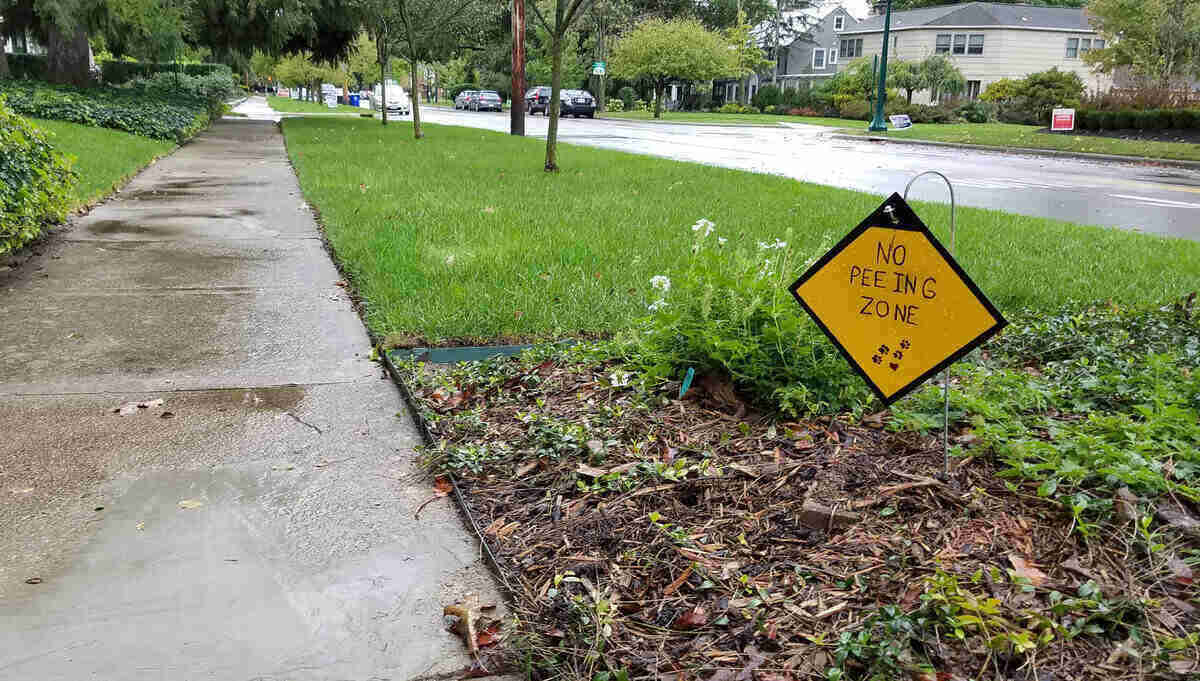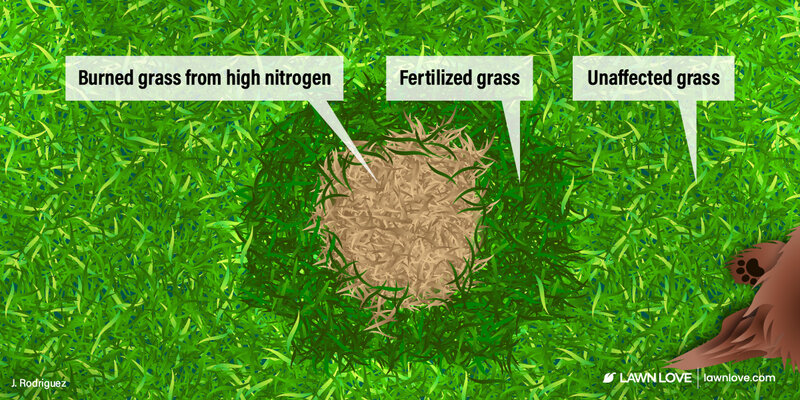
Does dog pee have your lawn looking ruff? Those brown or yellow spots, dark green patches, and even dead grass are all repairable. With reseeding and soil cleansing treatments, your lawn can be as good as new.
Lawn damage from dog urine
Before you can fix dog urine damage, you have to know where it comes from and what it looks like. Otherwise, you might end up wasting time on treatments for dog pee spots when your problem is actually something else (such as lawn pests or fungal diseases).

What causes dog urine damage
The first question to answer is: Why does dog pee kill grass? The reason is that dog pee contains a form of nitrogen and that nitrogen transfers to your soil when your dog goes to the bathroom in the lawn.
Your soil needs some nitrogen for the grass to grow healthy, but too much nitrogen concentrated in a small area “burns” the grass and kills it (just like over-fertilizing does). If your dog often urinates in the same few spots, there’s probably too much nitrogen in the soil in those areas.
What dog urine damage looks like

Damage from dog urine won’t cover every square inch of the lawn. Instead, it appears in small spots or patches that your dog frequents when doing their business. Those spots will either be brown or dark green and here’s why:
- Brown spots: If dog pee causes too much nitrogen in your soil, patches of grass will fade to yellow and eventually brown as they die. You’ll see a ring of dark green grass around the brown, where more diluted urine fertilized the grass instead of killing it.
- Dark green spots: If your soil lacks nitrogen in general, your dog’s urine will actually benefit the soil and act as a fertilizer. The result is patches of healthier grass that are darker green than the rest of your lawn.
Lucky for you (and your little dog, too), you can fix both kinds of dog pee spots with simple, relatively inexpensive DIY methods.
How to fix brown spots from dog urine

Brown grass means dead grass, but there can be life after death for your lawn. You can reseed to revive dead patches of grass that result from doggy potty time.
Reseeding means planting new grass seed in the affected area of the lawn to grow new, green grass from scratch.
Follow these steps to reseed dog pee spots:
- Step 1: Rake the brown patch thoroughly to get the dead grass and any other debris in your lawn out of the way. You should be able to see the soil.
- Step 2: Water the spot thoroughly to flush nitrogen and salts that come from dog urine out of the soil. Wait until the spot is moist but not sopping wet to move on to the next step.
- Step 3: Use a rake, trowel, or small cultivator to loosen the soil where you’re going to plant new seeds.
- Step 4: Cover the area with a mixture of two-thirds garden topsoil and one-third peat moss. Work the mixture into the loosened soil. If you choose to use fertilizer in your soil mix, don’t use one with high nitrogen content (remember, too much nitrogen is the problem we’re trying to fix).
- Step 5: Generously sprinkle grass seeds over the area. You can reseed using the same type of grass already growing in your lawn or a more damage-resistant grass type such as fescue or Bermudagrass. Don’t be afraid of using too much. The goal is about 20 seeds per square inch.
- Step 6: Water the seeds gently with a watering can or garden hose. Just a little water is fine. You don’t want to drown the seeds. Continue watering the newly seeded grass that same amount every day for a few weeks (except on rainy days).
- Step 7: Don’t walk across the new grass for a few weeks, and keep your dog away from it, too. It might be a good idea to cover the area with a protective material that still lets sunlight through. How long you have to wait for the new grass to establish its roots completely depends on the type of grass. Some varieties can be ready to go in as little as 30 days, while others take up to a year.
To help prevent dog urine damage in the future, reseed the brown spots with a urine-resistant grass type. Warm-season grasses such as Bermudagrass and St. Augustinegrass recover from urine damage better than cool-season grasses. Fescue is the most resistant cool-season grass.
How to fix yellow spots from dog urine
If your grass is yellow, that means it’s on its way to dying and turning brown. But there’s still hope! Your grass isn’t dead yet, and you may be able to save it by cleansing the soil of excess nitrogen and salts.
There are lawn treatments made specifically for dog urine spots. Some examples of these soil-cleansing products are:
- Spotless Lawn Dog Spot Aid
- Revive Dog Spot Treatment
- Envii Neuturine
- Scotts EZ Seed Dog Spot Repair
If the spots in your lawn are yellowing and not completely dead yet, cleansing the soil could be enough to save the grass, so you won’t have to reseed. But if the grass is dead, fixing the soil won’t bring it back to life.
How to fix dark green spots from dog urine

Remember, dark green lawn spots spring from a lack of nitrogen in your soil. When your dog urinates, the nitrogen from the urine is acting like fertilizer, greening the grass. You can fix the inconsistent coloring by fertilizing the rest of your lawn so all the grass turns the same lush, dark green as the urine spots.
Here are some tips for fertilizing your lawn:
- Get a soil test first. The results will tell you exactly what kind of fertilizer to buy to give your lawn all the nutrients it needs, not just nitrogen.
- Water and mow the lawn. Water the lawn a few days before fertilizing to help your soil absorb the nutrients better. Mow right before fertilizing so you have as much time as possible before the next cut after fertilization.
- Use a fertilizer spreader. Scattering fertilizer by hand often results in a spotty, inconsistent lawn, which is exactly what we’re trying to get away from. Spreaders give more even coverage.
- Fertilize on a regular schedule. Applying fertilizer to your lawn once won’t be enough to fix dark green spots for good. You should fertilize about five times a year, but the exact number and timing of fertilizations depend on where you live and your grass type.
Warning: Once you’ve corrected your soil so that your grass gets the proper amount of nitrogen, your dog’s urine may start to burn the grass. There’s a chance you’ll trade dark green spots for brown ones if you don’t do anything to prevent urine damage.
How to prevent dog urine spots
Urine spots aren’t inevitable. There are several steps you can take to protect your lawn from urine damage or make your dog’s pee less harmful.
These are some of the best methods for you to try:
- Follow your dog around the lawn and thoroughly water any spot where he goes to the bathroom as soon as he’s done.
- Use pee posts (which attract dogs with pheromones) and positive reinforcement (such as treats) to teach your dog to pee only in a designated spot covered with mulch or gravel.
- Mow the lawn as high as is recommended for your grass type. Taller grass is better at surviving and better at hiding bare spots.
- Put Dog Rocks in your dog’s water to reduce the nitrates she takes in from drinking.
- Change your dog’s diet to reduce the nitrogen in your pooch’s pee (only if your veterinarian approves the changes).
- Replace the grass currently in your lawn with a more urine-resistant variety if possible.
For more information about why these methods work and how you can apply them, see our complete guide to preventing dog urine damage.
FAQ about repairing dog urine spots
No, you shouldn’t use baking soda for dog urine spots. Baking soda contains salts that can dry out the soil and make the problem worse.
No. There’s a theory that feeding your dog apple cider vinegar or tomato juice prevents damage by altering the urine’s pH. However, it’s the nitrogen in dog urine, not the pH, that causes spots in lawns. So, apple cider vinegar or tomato juice won’t do anything to help.
The only real answer is water. After your dog does her business, water the spot thoroughly to dilute and spread the nitrogen from her urine.
Sometimes. Any dog that squats to pee is more likely to cause lawn damage than a dog that lifts its leg and marks with small amounts of urine in multiple places. Female dogs usually squat to pee, but so do puppies of all genders, most elderly dogs, and some young adult male dogs.
Get rid of those doggone brown spots
Even if your dog’s stinky business causes brown patches in your grass, you can fix them without too much trouble. With proper watering, mowing, fertilizing (and the occasional reseed), you can keep the brown spots on a cute dog where they belong and out of your lawn.
If you ever need help keeping your lawn spotless, call on Lawn Love’s local lawn care professionals.
Main Photo Credit: Dan Keck | Flickr | public domain